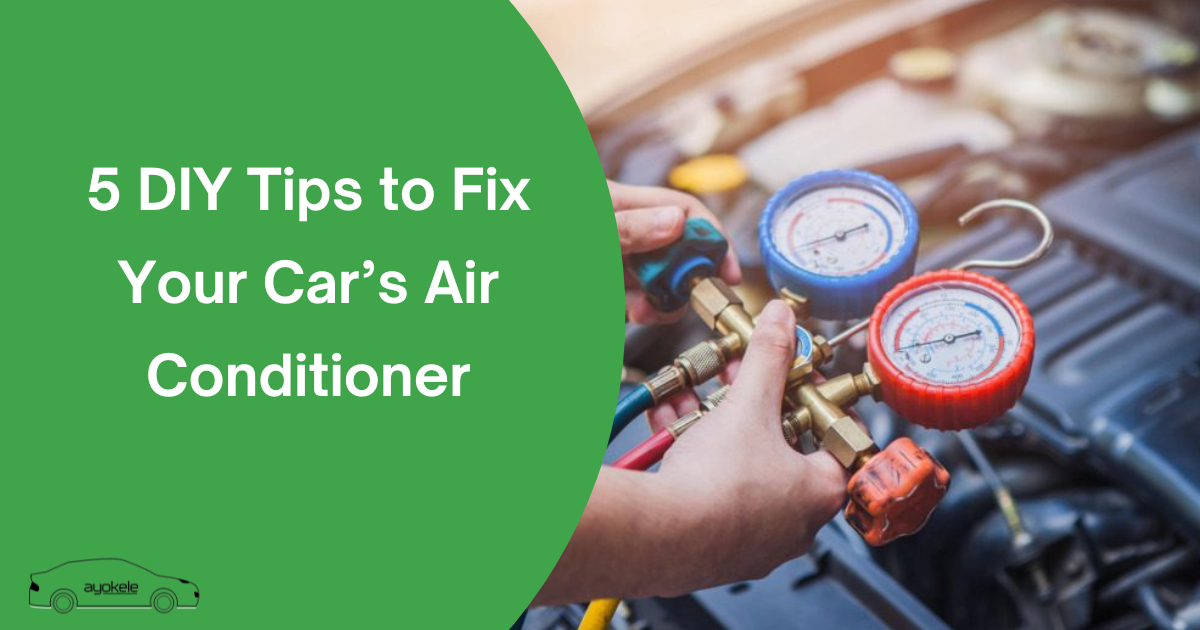A functioning air conditioner is essential for a comfortable driving experience, especially in our hot and humid climate. Whether you’re stuck in traffic or taking a long road trip, a properly working AC system can make all the difference. However, like any other car component, the air conditioner can develop issues over time, ranging from reduced cooling to complete failure.
The good news is that all of these problems can be fixed without the help of a mechanic. In this article, we’ll share five simple DIY tips to help you diagnose and fix common car AC issues. These quick fixes can save you both time and money while keeping your car cool and comfortable.
How Does a Car Air Conditioner Work?
A car air conditioner works by using a cooling system that relies on refrigerant to absorb heat from the inside of the car and release it outside. The process starts with the compressor, which compresses the refrigerant into a high-pressure gas and circulates it through the system. The refrigerant then passes through the condenser, where it cools down and turns into a liquid as heat is released.
Next, the liquid refrigerant flows through the expansion valve, which reduces its pressure and allows it to enter the evaporator. The evaporator absorbs heat from the car’s cabin and cools the air before blowing it back inside through the vents. This cycle repeats continuously to maintain a cool and comfortable temperature in your car.
The entire system is powered by the car’s engine and relies on components such as the blower fan, AC belt, and proper refrigerant levels to function effectively.
5 DIY Tips to Fix Your Car’s Air Conditioner
1. Check and Replace the Air Filter
A clogged air filter is one of the most common reasons for poor air conditioning performance. Over time, dirt, dust, and debris can block the air filter, reducing airflow and causing the AC to work harder than necessary. To fix this, locate the air filter, which is usually found behind the glove box or under the dashboard.
Inspect the filter to see if it’s dirty or damaged. If the filter is clogged, replace it with a new one. Most air filters are affordable and easy to install, requiring no special tools.
2. Inspect the AC Compressor
The AC compressor is the heart of your car’s cooling system, and if it’s not working properly, your air conditioner may blow warm air. To check the compressor, start your car and turn on the AC to the highest setting. Listen for any unusual noises, such as clicking or grinding, which may indicate a faulty compressor.
You can also inspect the compressor’s belt for signs of wear or damage. If the belt is loose or frayed, it may need to be tightened or replaced. While some compressor issues may require professional repair, minor problems like a loose belt can be easily fixed at home.
3. Recharge the Refrigerant
Low refrigerant levels are a common reason for weak or warm airflow from your car’s AC. You can purchase an AC recharge kit from an auto parts store to refill the refrigerant yourself. Before starting, locate the low-pressure port of your car’s AC system, usually marked with an “L.”
Follow the instructions on the recharge kit to safely add refrigerant to the system. Be careful not to overfill, as this can damage the AC components. After recharging, test the AC to ensure that it’s cooling effectively. If the refrigerant levels drop again quickly, there may be a leak in the system that requires professional attention.
4. Check for Leaks in the System
Refrigerant leaks can significantly affect your AC’s performance. Signs of a leak include a hissing sound, oily residue around AC components, or a sudden drop in cooling efficiency. To check for leaks, use a UV leak detection kit or soapy water. Apply the soapy water to the AC lines and connections, and watch for bubbles forming, which indicate a leak.
If you find a minor leak, you may be able to seal it using a refrigerant leak repair kit. However, larger leaks or leaks in hard-to-reach areas should be handled by a professional. Addressing leaks promptly prevents further damage to the AC system and ensures consistent cooling performance.
5. Clean the Condenser Coils
The condenser coils, located near the front of the car, can become dirty or blocked by debris over time. This reduces the efficiency of the AC system and may result in weak cooling. To clean the condenser, turn off the car and carefully remove any dirt, leaves, or debris from the coils using a soft brush or compressed air.
In some cases, the condenser may need to be washed with water or a specialized cleaning solution to remove stubborn dirt. Keeping the condenser clean ensures better airflow and improves the overall performance of your car’s air conditioner.
When to Seek Professional Help
While many car AC issues can be resolved with DIY fixes, some problems require the expertise of a professional mechanic. Knowing when to seek professional help can save you time, money, and further damage to your car’s air conditioning system.
1. Persistent AC Problems After DIY Repairs
If your car’s air conditioner still doesn’t work properly after attempting DIY fixes, it’s time to consult a professional. Issues like frequent refrigerant leaks, poor cooling, or unusual noises coming from the AC system could indicate deeper mechanical problems. A professional mechanic has the tools and expertise to diagnose and repair complex issues that may not be visible to the untrained eye.
2. Electrical and Compressor Issues
Problems with the AC’s electrical system or compressor are best handled by professionals. Electrical faults, such as blown fuses, wiring issues, or malfunctioning sensors, can be challenging to diagnose and repair without specialized equipment. Similarly, a failing compressor, which is critical to the AC system, often requires replacement or professional servicing to restore proper functionality.
3. Safety Concerns
Certain repairs, like handling refrigerants or fixing significant leaks, can pose safety risks if not done correctly. Refrigerants are pressurized and can cause burns or damage to the environment if mishandled. In such cases, leaving the repair to a professional ensures your safety and compliance with environmental regulations.
4. Preventing Further Damage
Attempting to fix complex AC issues without the right knowledge can lead to further damage, resulting in higher repair costs. Professionals can accurately identify the root cause of the problem and provide a long-lasting solution, saving you from recurring issues and unexpected breakdowns.
FAQs
1. Why is my car AC blowing warm air?
Your car AC may blow warm air due to low refrigerant levels, a clogged air filter, or a faulty compressor. Checking these components can help identify the issue. If the problem persists, it’s best to consult a professional.
2. How often should I recharge my car AC refrigerant?
Most car AC systems need a refrigerant recharge every 1–2 years, depending on usage. However, if you notice reduced cooling, it’s a sign that the refrigerant may be low and needs recharging.
3. Can I drive my car if the AC isn’t working?
Yes, you can drive your car if the AC isn’t working, but it may become uncomfortable, especially in hot weather. However, if the issue involves the compressor or electrical system, it’s better to have it inspected to avoid further damage.
4. What causes a refrigerant leak in a car’s AC system?
Refrigerant leaks can be caused by worn-out seals, damaged hoses, or corrosion in the AC system. Regular maintenance and timely inspections can help prevent or identify leaks early.
5. How can I prevent my car AC from breaking down?
To prevent breakdowns, regularly clean the air filter and condenser, ensure refrigerant levels are adequate, and inspect components like the compressor and belts. Routine maintenance can significantly improve the lifespan of your car’s AC system.
Keeping your car’s air conditioner in good condition ensures comfort and reliability, especially in our hot climate. Regular maintenance and prompt repairs can save you time and money while keeping you cool on the road.




